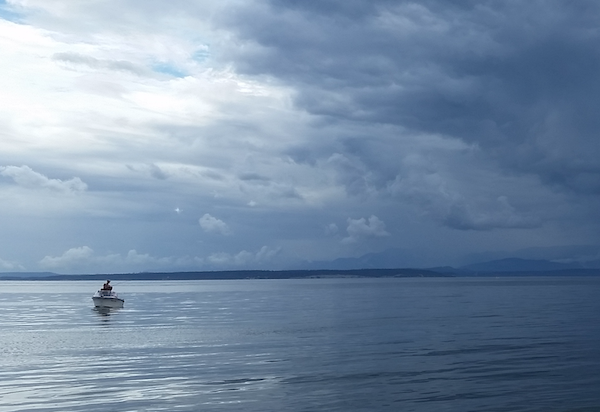
Wash. Salmon ‘Still Struggling,’ State Report Finds
Yesterday’s release of the State of Salmon in Watersheds report came at a particularly rough moment for Washington stocks.

True, the 32-page report highlights bright spots – Snake River fall Chinook, Lower Columbia coho – but its delivery follows on a grim three-day stretch earlier this month in which the feds announced the Evergreen State’s crown jewel fish, Olympic Peninsula steelhead, may warrant a federal ESA listing, which would bring to 15 the number of salmonid populations in Washington that are threatened or endangered, and forecasters predicted what would be all-time-low return of Snake River summer steelhead this year.
The latter fish are called out in Watersheds as having shifted from “making progress” in 2020’s edition to “not keeping pace” as a series of down years post-Blob stretches on and on and on.
For bad measure, it was also revealed in that three-day run that there would be no keeper sturgeon season in 2023 on the Columbia below Bonneville, effectively reinforcing and broadening the challenges identified in the biannual salmon reckoning: habitat loss, stream temperatures and flows, predation, passage barriers, climate change – the list continues.
In a Washington Recreation and Conservation Office press release accompanying Watersheds and headlined “New Report Says Salmon Still Struggling,” Governor Jay Inslee pleads for immediate action, particularly on the habitats Chinook, coho, sockeye, pinks, chums and steelhead depend on.
“Salmon need our help, now,” Inslee said. “Salmon are essential to our identity, ecosystems and economy. We can’t wait to save them – we have to invest in their recovery right away by restoring habitats and doing everything possible to repel threats to their survival.”
Three riparian bills he’s introduced in the legislature over the last 13 months have stalled, but after negotiations between tribal and agricultural leaders a bipartisan bill that’s more focused on voluntary measures is getting some traction in the House of Representatives and is before the Capitol Budget Committee today. According to a press release from House Republicans, $200 million in requested funding has been attached to it.
Per Watersheds, Snake River spring/summer Chinook, Upper Columbia spring Chinook and Puget Sound Chinook and steelhead continue to be “in crisis,” while along with Snake River steelhead, Lower Columbia Chinook and chums, and middle and upper Columbia steelhead are “not keeping pace.”
After two relatively strong years, Lower Columbia coho moved into the “making progress” column and that could continue in 2023, at least if the Oregon Coast/Columbia ocean abundance forecast of 1.135 million verifies. Lower Columbia steelhead are also finding headway.
And along with Hood Canal summer chums, Snake River fall Chinook continue “approaching goal.” The latter stock dipped as low as just 771 fish at Ice Harbor Dam in the years following completion of the four dams on Washington’s lower Snake but has since climbed to as many as 62,978 during good ocean conditions in the middle 2010s and last year saw 44,274 falls. A ton of credit goes to decades of focused restoration efforts by the Nez Perce Tribe.
Watersheds points to other progress, including correcting 3,750 fish passage barriers, 4,734 miles of streams made accessible to fish, 10,454 acres of estuary and near-shore habitat restoration and 26,342 acres of riparian treatment between 2005 and 2022.
RCO also notes pending or proposed projects, like plans to set levees back or remove them on the Yakima to give the river room to roam and provide more side channel habitat, while a new bridge over the Duckabush should help restore its estuary on Hood Canal.
“There is a lot of incredible work being done to recover salmon across the state,” said Eric Neatherlin, Governor’s Salmon Recovery Office director, in a press release. “To get abundant salmon populations will require us to remove barriers, discard outdated preconceptions, listen to each other and elevate our shared values. I am confident Washingtonians will rise to the challenge.”
And the state and tribes also have expanded federal authority to remove sea lions in the Columbia, more money is being paid to northern pikeminnow sport-reward fishery participants, and there’s increased focus on breaching the Lower Snake dams even as less controversial concrete plugs elsewhere are being removed – Elwha, White Salmon, Pilchuck, Nooksack, Sultan.
In drawing attention to that low Snake summer steelhead forecast, ODFW pointedly notes the fish “consistently have lower life-cycle survival rates than mid-Columbia steelhead which only have to pass three or four dams.”
Still, Watersheds identifies issues like increasing water temperatures and summer heat that can’t be addressed by taking out dams. The recent death of the Hinman Glacier in the headwaters of the Skykomish River and once the largest ice sheet between Mt. Rainier and Glacier Peak is an example of how long-term rises in freezing levels and winter snowpack declines are leading to less cool water available in late summer for returning salmon.
While the report offers one gauge of Evergreen State salmon populations, another will be revealed in the coming weeks at North of Falcon, where the 2023 forecasts for Western Washington Chinook, coho, sockeye, pinks and chums for this coming season’s fisheries will be revealed. That begins as early as March 1 for Willapa Bay and Grays Harbor and March 3 for Puget Sound. Presentations – if they’re anything like recent years – will include details on salmon return trends and what are impacting them.
